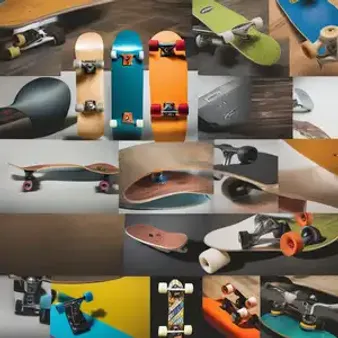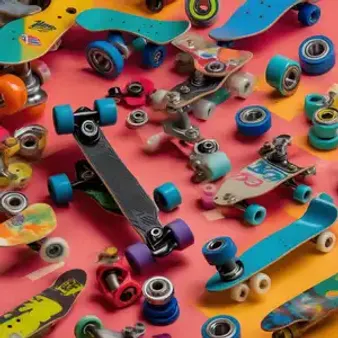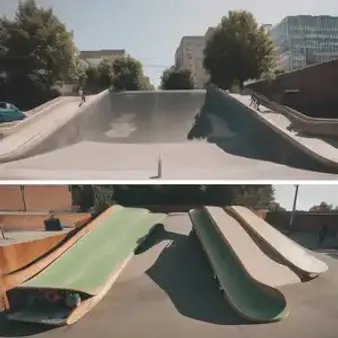Table of Contents
Have you ever wondered how pro skaters make those mind-blowing tricks look so effortless? A big part of it comes down to their pro skaters setups. At kizworld, we're breaking down the mystery behind these meticulously crafted machines. Get ready to explore the decks, trucks, wheels, and all the fine details that go into creating a pro's dream ride.
Component | Key Considerations | Impact on Performance |
|---|---|---|
Deck | Width, length, concave, shape | Overall board feel, pop, stability |
Trucks | Height, width, geometry | Turning responsiveness, stability, grind clearance |
Wheels | Size, durometer, shape | Speed, grip, ride smoothness |
Bearings | Precision rating, material | Rolling speed, durability |
Bushings | Hardness, shape | Turning resistance, stability, lean |
Deconstructing Pro Skaters Setups: Decks and Wheels
Alright, let's talk about pro skaters setups, starting with the foundation: decks and wheels! Think of the deck as the skateboard's body and the wheels as its feet. Just like you wouldn't wear snow boots to go surfing, you gotta pick the right gear for the type of skating you're into.
Deck Talk: Size and Shape Matter
Decks come in different sizes and shapes, each affecting how the board feels and handles. Width is super important, especially for us with growing feet! A wider deck gives you more foot space for landing tricks and feeling stable. Length matters too, longer decks are good for cruising and stability, while shorter ones are easier to flip and do tricks on. Then there's the concave, that's the subtle curve from side to side underneath the deck. It gives your feet something to grip and helps you pop those ollies. Pro skaters choose their deck shape and size based on their height, shoe size, and the type of skating they do. It's like Goldilocks finding the perfect porridge, but for skateboarding!
Wheel Wisdom: Rollin' Right
Now, let's roll onto wheels! Remember those skateboarding wheels and bearings? They're a big deal. Wheels come in different sizes, measured in millimeters (mm), and hardnesses, measured by a durometer scale. Bigger, softer wheels (like 56mm and above) are awesome for cruising, rough surfaces, and even surf skating. They roll over cracks and pebbles like it's nothing. Smaller, harder wheels (like 52mm and below) are faster and better for street skating, doing flip tricks, and grinding. Durometer is all about how hard or soft the wheel feels. A lower number means a softer wheel, which grips better but is slower. A higher number means a harder wheel, which is faster and slides easier. Imagine trying to ride on wheels made of jelly – that's a low durometer! Now imagine wheels made of stone – that's a high durometer! Pro skaters choose their wheels based on the type of skating they do and the surfaces they ride on.
Wheel Size | Best For |
|---|---|
50-53mm | Street, parks, tech tricks |
54-56mm | All-around skating, cruising, ramps |
57mm and up | Longboarding, cruising, rough surfaces |
Deconstructing Pro Skaters Setups: Decks and Wheels
The Heart of the Setup: Pro Trucks and Bearings
Alright, so we've covered decks and wheels, but now let's talk about the heart of every pro skater setup: trucks and bearings. Trucks are like the steering wheel of your skateboard. They're what let you turn, grind, and basically do all the cool stuff. Just like you wouldn't want wobbly wheels on your bike, you need trucks that match your skating style.
Trucks: Your Skateboard's Steering Wheel
Trucks are made up of a bunch of parts, but the main things to think about are the height and width. Taller trucks give you more clearance for wheels, which is awesome for surf skating or if you like bigger wheels. Lower trucks are more stable and responsive, making them perfect for street skating and technical tricks. Width is important too – you want your trucks to match the width of your deck. Too narrow, and you'll feel unstable. Too wide, and your wheels might stick out, making it harder to control. It's all about finding that sweet spot!
Bearings: The Little Engines That Could
Now, let's talk about bearings – those tiny metal rings that fit inside your wheels. They might be small, but they're super important because they're what make your wheels spin! Bearings are rated on something called the ABEC scale. The higher the ABEC rating, the faster and smoother your bearings will roll. But here's the thing – higher ABEC ratings don't always mean better. For most skaters, especially beginners, a lower ABEC rating like 3 or 5 is totally fine. They're durable, affordable, and still give you a good roll. Pro skaters often go for higher ABEC ratings because they need that extra speed and precision. Think of it like this: if your skateboard is a car, bearings are the engine oil – they keep everything running smooth!
The Heart of the Setup: Pro Trucks and Bearings
FineTuning the Ride: Bushings and Hardware
Okay, we've got our decks, wheels, trucks, and bearings sorted. Now, let's fine-tune our setups with bushings and hardware – the little details that make a BIG difference. Think of bushings like the suspension system of your skateboard. They're those little rubbery rings that go inside your trucks and affect how your board turns and leans.
Bushings: Dialing in Your Turns
Bushings come in different shapes and hardnesses, and choosing the right ones can seriously up your skating game. Harder bushings give you a more stable and responsive ride, which is great for quick turns and carving. Think of it like driving a go-kart – you want those sharp, precise movements! Softer bushings, on the other hand, give you a smoother, more surfy feel, perfect for cruising and carving bowls. It's like riding a wave – nice and flowy. Experiment with different bushing hardnesses to find what feels best for your style and the type of skating you do. It's all about finding that sweet spot where you feel totally in control. Some pro skaters even use different bushings on their front and back trucks to fine-tune their turning even more!
Bushings Hardness | Best For |
|---|---|
Hard (96A and up) | Technical street skating, quick turns, stability at high speeds |
Medium (90A-95A) | All-around skating, good balance of responsiveness and stability |
Soft (89A and below) | Cruising, carving, smooth and surfy turns |
Hardware: Keeping It All Together
Last but not least, let's talk about hardware – the nuts and bolts that hold your skateboard together! You might be thinking, "Really? Hardware?" But trust me, using the right hardware can make a big difference in how your board feels and performs. Always use high-quality skateboard hardware that's the right size for your trucks and deck. Loose hardware can make your board feel wobbly and unsafe, while over-tightening it can strip the screws or even damage your deck. It's like building a house of cards – you want a solid foundation!
- skateboard-back-pack
- skate-tony-hawk
- wknd-skateboards
FineTuning the Ride: Bushings and Hardware
Pro Inspiration: Iconic Skaters Setups
Tony Hawk's Birdhouse Setup
Let's talk about Tony Hawk, the legend himself! He's known for his vert skating, which means flying high on those massive halfpipes. To handle all that airtime, his Birdhouse setup usually features a wider deck for stability and bigger wheels for speed. It's all about smooth landings and powerful carves. Think of it like this: if you're riding a rollercoaster, you want a sturdy cart with smooth wheels, right? Same idea with vert skating!
Now, imagine trying to do a delicate ballet dance on a skateboard. That's kind of what street skating is like – all about precision, balance, and technical tricks. Someone like Nyjah Huston, the street skating master, needs a setup that's super responsive. He usually goes for a narrower deck for flipping and doing tricks, smaller, harder wheels for quick turns and slides, and lower trucks for stability. It's all about those lightning-fast movements and landing tricks with pinpoint accuracy.
Skater | Setup Style | Key Features |
|---|---|---|
Tony Hawk | Vert | Wider deck, bigger wheels, higher trucks |
Nyjah Huston | Street | Narrower deck, smaller wheels, lower trucks |
Daewon Song's Almost Round Setup
Ever heard of Daewon Song? This guy's a skateboarding innovator, famous for his creative and mind-blowing street skating. What's unique about his setup is that it's almost round! He rides a deck with a really steep concave, almost like a bowl, which allows him to do these crazy, gravity-defying tricks. His setup is all about pushing the boundaries of what's possible on a skateboard. It's like he's reinvented the wheel, literally!
These are just a few examples of how pro skaters tailor their setups to their own unique styles and the type of skating they do. It's like choosing the right paintbrush for a painting – each one creates a different effect. Remember those articles on how to do a 180 and how to get started with skateboarding? Having the right setup can make a big difference in how you progress and what you can achieve.
- skateboard-back-pack
- skate-tony-hawk
- wknd-skateboards
Pro Inspiration: Iconic Skaters Setups
Final Thought
Pro skaters setups are more than just a collection of parts; they're an extension of the skater's style, preferences, and the tricks they aim to conquer. While aspiring to ride like a pro is awesome, remember that finding the setup that feels right for you is the key to unlocking your own skateboarding potential. So, get out there, experiment, and have a blast finding your perfect ride!